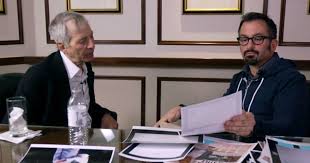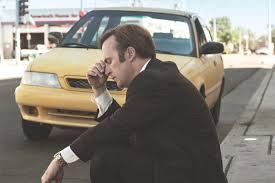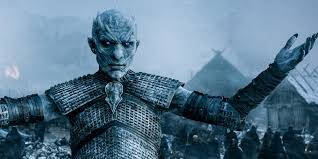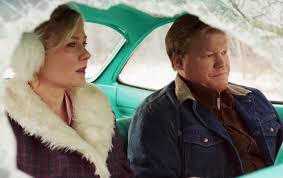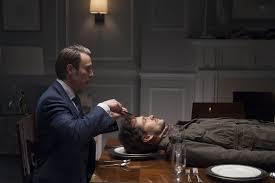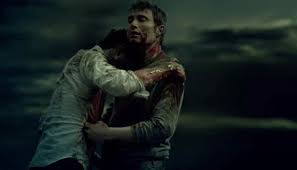5. THE JINX (HBO)
(Spoilers for The Jinx, but come on, this is real life)
I’ll never forget how powerful and affecting Errol Morris’ The Thin Blue Line was when I first saw it, especially after learning that it was a crucial component in getting an innocent man out of jail. With HBO’s The Jinx, we’ve been given the darker side of this endeavor – a documentary that helped put a guilty man in prison. And it’s one of the most chilling, unbelievable, and unforgettable television experiences you’ll ever have.
A lot of that has to do with the intense focus given to the series’ subject, Robert Durst. Allowing a majority of the story to be told from Durst’s own mouth makes him into one of the most complicated and tragically evil characters ever put on screen. Throughout the show, you will hit the highest heights of sympathy for this incredibly damaged human being and the lowest lows, finding him utterly despicable and conniving. If the episode about his trial in Texas doesn’t leave you flabbergasted and outraged, I don’t know what to do with you.
And the ending is something so thrilling and unpredictable that it feels fabricated, even though it’s viciously clear that it isn’t thanks to one character’s emotional response. The Jinx really does prove the old axiom about truth being stranger than fiction. It can also be more exciting, and for as dark as The Jinx is, it’s equally enthralling. Anytime that film enacts genuine change in the world, it demands to be seen. The Jinx is no exception.
Defining Moment: “What the hell did I do?” The ending of The Jinx is vindicating, depressing, creepy, disgusting (“And the burping.”), and easily one of the greatest finales to any story told in 2015.
– Drew Dietsch
4. BETTER CALL SAUL (AMC)
I thought Better Call Saul was a terrible idea, precisely because Breaking Bad is one of the very best dramas in the history of television. Saul Goodman was entertaining as sleazy comic relief there, but didn’t seem to have the layers to be a dramatic lead in his own right. What’s more, it was a prequel, without any obvious way around the fact that it could only slowly walk us up to the point where things got really interesting for the character. This is only exacerbated by the focus being on the origin story of Saul as a corrupt small-timer; there is an arc there, but it’s just a watered down, diet version of Mr. White’s transformation into Hiesenberg, right?
But I’m glad to be able to report that I was wrong, and Better Call Saul, while it will probably never rival Breaking Bad for space on Television’s Mt. Rushmore, is one of the best shows of the year. The humor of the character survives, but Bob Odenkirk carries the increased dramatic load with aplomb, giving the erstwhile Jimmy McGill an honest-to-God soul, without entirely overwriting the cheerfully amoral character we grew to love entirely. The cinematography is also better than most feature films, despite rarely being as showy as that of The Knick or some of the remaining series on this list. It’s a subtly powerful character study that also happens to be a surprisingly accurate look at a less glamorous corner of the legal profession than television usually has time for. It’s a minor triumph for AMC, which needs it with Mad Men following BB off into the sunset this year, and The Walking Dead operating in a strange space where it is somehow massively popular and seemingly despised by its own fans. Season 2 can’t come fast enough.
Defining Moment: The obvious route would be the Mike-centric “Five-O”, which was undeniably the single most powerful hour the show produced, but also too anomalous in its focus to give a proper impression of what the show is about. So I’ll say Odenkirk’s amazing, bitter Bingo monologue at the end of the season.
– Al Schwartz
3. GAME OF THRONES (HBO)
While I enjoyed the previous season a bit more, this was another stellar season for Thrones. We saw the further spreading of the Westerosi ensemble to other lands; a strategic series of movements around the game board that keeps the series fresh and the characters evolving. Arya came to Braavos to find Jaqen H’ghar and become one of The Faceless. Varys and Tyrion (a brilliant pairing) escape King’s Landing to go crash at Daenerys’ palace in Mereen, whose civil unrest explodes in a shockingly violent fashion. In one of this season’s lesser storylines, Jamie and Bronn are sent to Dorne, where they wind up imprisoned by the perpetually scowling and catty Dornish royal family. Back in Westeros, young Tommen is bangin’ Margaery, and Cersei gets a taste of her own wickedness when a religious zealot (a welcome Jonathan Pryce) proves more difficult to control than she supposed. In the most tragic story of the season, Sansa is brought back to her childhood home at Winterfell and forced to marry sadistic rapist Ramsay Bolton under the eyes of the broken Theon “Reek” Greyjoy. Meanwhile, Jon Snow ascends to a leadership position the Night’s Watch and attempts convince the Wildlings to join the fight against the White Walkers. In the season’s best sequence, an army of Wights descends (and literally plummets) upon the Wildling settlement of Hardhome, laying waste to the camp and the ranks of their undead army, but revealing a potential weakness of the Walkers in the process.
While I think many of this season’s episodes were impeccably written, but to be honest I want a bit more directorial flair in this series. Its beautifully-crafted but homogenous style is feeling just a little stale to me for such a narratively ambitious and daring show, particularly compared to the next two shows on the list. But the farther our main characters got from Westeros this season, the more interesting it got from a narrative perspective. With the show having caught up to the release of the source novels, there is more potential than ever for next year to go completely off the rails, but pretty much all of us will be glued to our sets each Sunday to see exactly how much worse things can get in Westeros.
Defining Moment: the Night’s King on the shore of Hardhome, arms raised, smirking at the escaping humans.
– Travis Newton
2. FARGO (FX)
Fargo kinda stole True Detective’s destiny: an anthology show that draws critics and big screen actors to it like flies to pie. Where True D completely bolloxed its sophomore outing (to the point where season three hasn’t even been mentioned under HBO’s breath), Fargo simply continued delivering Coen-esque absurdity and stick-to-your-ribs storytelling with a confidence, playful style and pitch black sense of humor. The hyperlink between the two seasons is a tale told during the first about a massacre that happened in Sioux Falls in the late 70s. Lou Solverson, a police officer played by Keith Carradine in the first and Nick Nunziata favorite Patrick Wilson in the second, is the moral compass that tries and tries and tries to calm the turbulent waters before they drown his whole world. The lead up to the aforementioned bloodbath involves the Gerhardts, a local crime family in disarray, the Missouri mob syndicate that’s looking to take advantage of the Gerhardts’ weakened state, and a hapless young couple caught in the middle of the two.
Noah Hawley, the creator and main writer of the show, just goes all Rumpelstiltskin here…seemingly spinning gold out of…bushy Coen hair? (Look, I was pressed for time. Give me this one.) show is littered with lifts from the brothers’ movies: the forest march from Miller’s Crossing, the Angel of Death stuff from No Country, Fargo‘s remote cabin location, the Dapper Dan hair stuff from O Brother (I wish!). And the show makes these scenes integral to the plot of the show…they aren’t just winks, but it’s also not as though you need to understand what’s being referenced for them to make sense in the moment. Anyway, the thing is a joy to watch on so many levels. I think Breaking Bad is just as heavly of an influence on the show as the Coens, given the genre and time it debuted, but Fargo’s ensemble storytelling is an even higher-wire act than BB’s relatively narrow focus on Mr. White’s progression. The show seems as finely crafted and perfectly sound tracked as the show that made meth sexy, which is high praise indeed. Plus, for all you Art Bell fans, there’s a bunch of UFO stuff stirred in this year.
The standout performances include Kirsten Dunst and a burgered-up Jesse Plemons as the in-over-their-head couple, Bokeem Woodbine in a career-best role as an eccentric Kansas City enforcer, Jeffrey Donovan (ex-Burn Notice) as the would-be/wannabe heir to the Gerhardt dynasty, and Zahn McClarnon as the enigmatic but brutally efficient Hanzee, a Native American tracker that works for the Gerhardts and becomes the unstoppable beating heart of the show. But really just throw a dart. Everyone here is great: Nick Offerman, Jean Smart, Ted Danson, Cristin Milioti, Johnny Depp…oh, wait, I’m thinking about his cameo in Kevin Smith’s movie TUSK. Again. Bruce Campbell, who is a walking-talking Coen Brothers reference, does show up as a pre-prez Ronny Reagan, though. Because the universe can occasionally be kind.
Defining Moment: Dunst teaches a thug about Minnesotan manners, with a kitchen knife and a can of beans.
1. HANNIBAL (NBC)
Even the most delicious meal has to end at some point, and it’s better to finish on a satisfying smile than bloated exhaustion. Luckily, divine intervention made it impossible for Brian Fuller to eventually spoil the broth. Falling ratings, MGM’s ongoing refusal to allow Silence of the Lambs characters to be used, and Fuller’s own impending work on the American Gods series stopped him from going on as planned past the Red Dragon arc. But a premature ending may actually have been the best thing that could have happened to the series.
Season 3 consisted of two halves, and while both of them kept the Oscar level acting, direction, set design, and editing, the wine had been opened for too long already. The first half was an interesting but overstuffed mess that tried to bring closure to the depraved Vergers first and foremost. It brought back the characters of Abigail and Bedelia, it did the Il Mostro Pazzi case from the movie Hannibal, and there was even room for it’s own spin on Hannibal Rising. Cramming all of that into one big casserole, the series had lost some of its unhurried elegance from seasons past.
The second half thankfully dialed down both the volume for a powerful re-telling of the Red Dragon storyline. It was fairly good work, especially from Richard Armitage as the title character, but if you’ve read the book and seen both Manhunter and Red Dragon already, it may have felt a little straightforward compared to the show’s typically skewed approach to adaptation. But that doesn’t detract anything from the power of the final images of the show: Graham and Lecter have had a fascinatingly perverse relationship, as cop and criminal, as victim and psychologist, as friend and mentor, with a mutual understanding and ambiguous traces of attraction. The way the series leaves these two behind might be controversial, but it feels operatic, fulfilling, and deserved. A great dessert.
Defining Moment: That final embrace.
– Flynn Keaton

